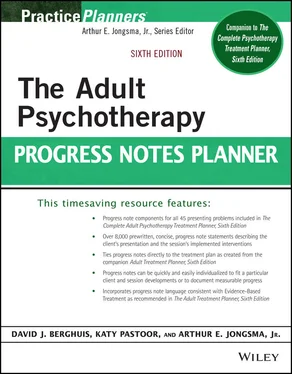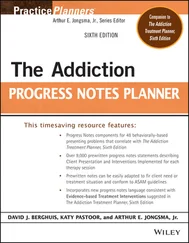39 Use Interpersonal Therapy Techniques to Resolve Interpersonal Problems (39)Interpersonal therapy techniques were used to explore and resolve issues surrounding grief, role disputes, and role transitions.The client was provided with direction and training in regard to skill deficits.Support and strategies for resolving identified interpersonal issues were provided.Encouragement and reinforcement were provided to the client for successful resolution of interpersonal problems.
40 Establish a Rescue Protocol (40)A rescue protocol was developed, in order to identify and manage clinical deterioration.Specific factors that would trigger the rescue protocol were identified.Specific factors of the rescue protocol were developed, including medication use, sleep pattern restoration, daily routine, and conflict-free social support.The client and significant others were reinforced for their use of the rescue protocol.The client and significant others were redirected in regard to the use of the rescue protocol.
41 Schedule “Maintenance” Sessions (41)The client was scheduled for a “maintenance” session between 1 and 3 months after therapy ends.The client was advised to contact the therapist if he/she/they need to be seen prior to the “maintenance” session.The client's “maintenance” session was held and he/she/they were reinforced for his/her/their successful implementation of therapy techniques.The client's “maintenance” session was held and he/she/they were coordinated for further treatment, as his/her/their progress has not been sustained.
42 Assign Reading on Bipolar Disorder (42)The client was assigned to read or view material on bipolar disorder.The client was assigned to read The Bipolar Disorder Survival Guide (Miklowitz).The client was assigned to read The Bipolar Disorder Workbook (Forester and Gregory).The client was assigned to read Bipolar 101 (White and Preston).The client has read the assigned information on bipolar disorder and key concepts were reviewed.The client has not read the assigned information on bipolar disorder and was redirected to do so.
43 Pledge Support (43)The client was reassured on a regular basis that the therapist would be available to consistently listen to and support him/her/them.The client reacted favorably to the therapist's pledge of support and has begun to show trust in the relationship by sharing thoughts and feelings.
44 Explore Abandonment Fears (44)The client's fear of abandonment by sources of love and nurturance was explored.Active-listening skills were used as the client confirmed that he/she/they struggle with the fear that those who have provided love and nurturance to him/her/them will eventually abandon him/her/them.The client denied any fear of abandonment by sources of love and nurturance; he/she/they were urged to monitor this on an as-needed basis.
45 Differentiate Losses (45)The client was helped to differentiate between real and imagined, as well as actual and exaggerated, losses.The client was supported as he/she/they verbalized grief, fear, and anger regarding real or imagined losses in life.The client was helped to make a differentiation between his/her/their real and imagined losses, rejections, and abandonment.The client was quite guarded and unrealistic about his/her/their pattern of losses and was provided with feedback in this area.
46 Probe Losses (46)Real or perceived losses in the client's life were explored.Active listening was used as the client confirmed that he/she/they have unresolved feelings regarding losses that have been experienced.It was interpreted to the client that his/her/their experience of loss has precipitated fears of abandonment in other relationships.The client denied any significant losses in his/her/their life, and this was accepted.
47 Process Losses (47)The client's experiences of loss were processed in an attempt to place losses in perspective.The client was helped to identify adaptive ways to replace the losses that were experienced.The client failed to process and develop adaptive ways to replace losses that have been experienced and was gently offered examples of how to do this.
48 Explore Family-of-Origin History (48)The client was supported as he/she/they shared experiences from his/her/their family-of-origin history that have caused feelings of low self-esteem and fear of abandonment.The client was supported as he/she/they revealed experiences with critical and rejecting parents that led to feelings of low self-esteem.The client disclosed experiences of childhood abandonment by parent figures; these have been noted to lead to the fear of abandonment in current relationships.The client was quite guarded about his/her/their family-of-origin history and was urged to be more open in this area, as he/she/they feel capable of doing so.
49 Confront Grandiosity (49)The client's grandiosity and demandingness were gradually, but firmly, confronted.The client was assigned “What Are My Good Qualities?” from the Adult Psychotherapy Homework Planner (Jongsma).The client was assigned “Acknowledging My Strengths” from the Adult Psychotherapy Homework Planner (Jongsma).The client has become less expansive and more socially appropriate with the consistent confrontation of his/her/their grandiosity and demandingness.The client has reacted with anger and irritability when his/her/their grandiosity was confronted.
1 1The numbers in parentheses correlate to the number of the Behavioral Definition statement in the companion chapter with the same title in The Complete Adult Psychotherapy Treatment Planner, Sixth Edition, by Jongsma, Peterson, and Bruce (Hoboken, NJ: Wiley, 2020).
2 2The numbers in parentheses correlate to the number of the Therapeutic Intervention statement in the companion chapter with the same title in The Complete Adult Psychotherapy Treatment Planner, Sixth Edition, by Jongsma, Peterson, and Bruce (Hoboken, NJ: Wiley, 2020).
BORDERLINE PERSONALITY
CLIENT PRESENTATION
1 Relationship Instability (1) 1 The client described a pervasive pattern of instability of interpersonal relationships, self-image, affect, and marked impulsivity.The client's unstable relationship, affect, and self-image patterns began in early adulthood and have been consistent since that time.The client's unstable relationship, affect, and self-image patterns are present in a variety of contexts throughout adulthood.The client's patterns of relationship, affect, and self-image instability have been reduced.
2 Abandonment Fears (2)The client described a history of becoming very anxious whenever there is any hint of abandonment present in an established relationship.The client's hypersensitivity to abandonment has caused him/her/them to place excessive demands of loyalty and proof of commitment on relationships.The client has begun to acknowledge his/her/their fear of abandonment as being excessive and irrational.Conflicts within a relationship have been reported by the client, but he/she/they have not automatically assumed that abandonment will be the result.
3 Chaotic Interpersonal Relationships (3)The client has a pattern of intense, but chaotic, interpersonal relationships as he/she/they put high expectations on others and is easily threatened that the relationship might be in jeopardy.The client has had many relationships that have ended because of the intensity and demands that he/she/they placed on the relationship.The client reported incidents that have occurred recently with friends, whereby he/she/they continued placing inappropriately intense demands on the relationship.The client displays interpersonal relationships that are characterized as alternating between extremes of idealization and devaluation.The client has made progress in stabilizing his/her/their relationship with others by diminishing the degree of demands that he/she/they place on the relationship and reducing the dependency on it.
Читать дальше












